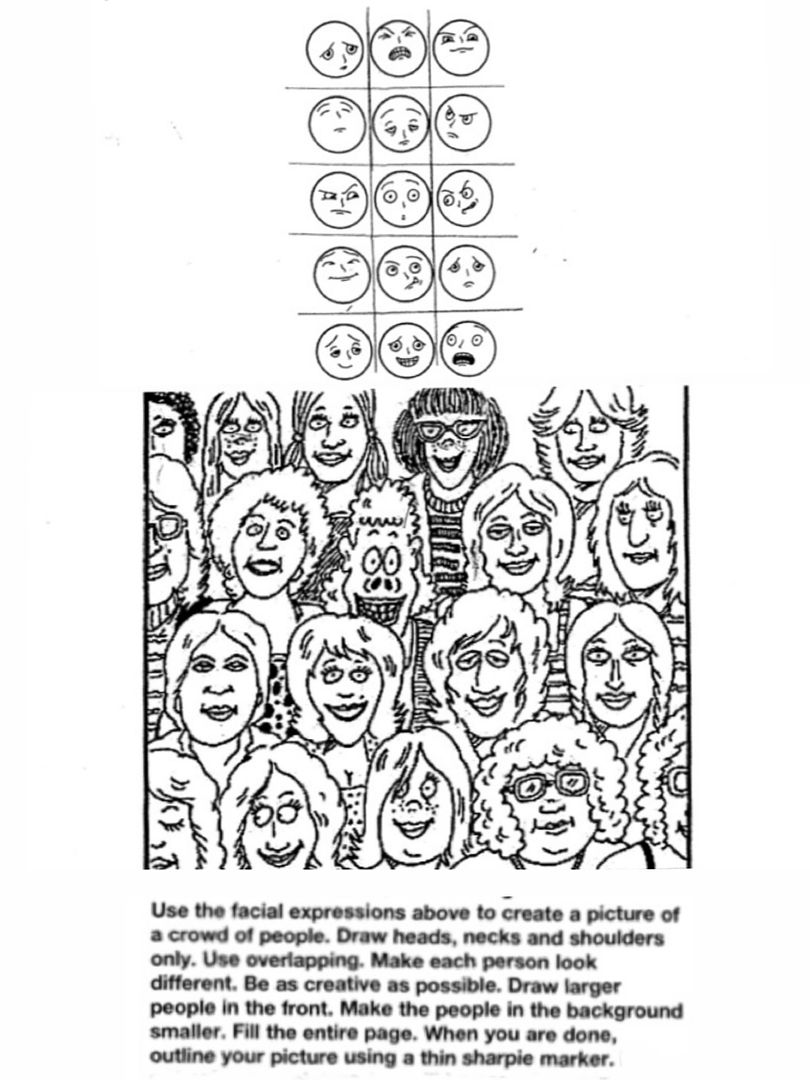The handout below shows the basic proportions of the human face. Notice that the eyes are in the middle, not the top of the head. The person looks like an egg head because the hair is missing. Most students, prior to instruction, place the eyes and the hair too far up on the head.
This excellent video explains how knowledge of proportion is the first step towards being able to draw portraits.
I downloaded the brief excerpt above from the television show "James May's Man Lab" Series 2 Episode 1. You can view the complete episode by clicking on this link:
 |
| Basic proportions of the human face |

Look through magazines or the Internet to find photographs of people to draw.
 |
| Face turned 3/4 view |

Now that you've drawn realistic faces it's time to experiment with cartoon faces. Try using exaggeration and distortion as an expressive tool.
Self portrait with masks
James Ensor 1899
Caricatures and doodles on a blotter used at a Transit of Venus Committee meeting at the Royal Society in 1882. Individuals identified include (left to right): Robert Arthur Talbot Gascoyne-Cecil, third Marquess of Salisbury, prime minister; George Carey Foster, chemist and physicist; Alexander William Williamson, chemist; Sir William Henry Mahoney Christie, astronomer; Warren de la Rue, chemist and astronomer; Thomas Henry Huxley, biologist; John Ball, glaciologist; Sir George Gabriel Stokes, physicist; and William Grylls Adams, scientist
Downloaded from:
http://www.theguardian.com/science/gallery/2012/apr/19/picture-library-royal-society-history?index=5
STUDENT GALLERY

Drawings and animations by McGinnis School students.
 |
| From the sketchbook of Edgar Degas Orchestra of the Opera, 1869, by Edgar Degas |
STUDENT GALLERY

Drawings and animations by McGinnis School students.
 |
| Inventory of facial expressions by a 6th grade student |
 |
| Crowd of people by a 5th grade student |
 |
| Crowd of People by 5th grade student |
 |
| Crowd of People by 5th grade student |
 |
| Crowd of people by 5th grade student |
A video of digital artwork and iPad animations by 5th grade students from William C. McGinnis School:
Click here to visit About.com for a free drawing lesson on portraiture (how to draw faces). Very detailed and informative with pictures showing every step.
Click here to visit the website of the National Portrait Gallery in London
Click here to visit the website of the National Portrait Gallery in Washington DC. There are portraits here of every single US president and many other famous Americans.
Since it's a bit confusing to navigate the (US) National Portrait Gallery's website I have added this direct link to their collections search.
For more lessons on faces please refer to my other posts;
Below are two pictures, by the artist William Hogarth, of crowds of people
Related art lessons:
Have you ever looked at a person and been reminded of an animal? Have you ever compared someone energetic and young to a puppy? We are all familiar with terms like 'clever like a fox', 'gentle as a teddy bear' and 'cute as a bunny'. Back in the 1600's some people actually believed that you could judge a person's character by figuring out what animal they most resembled.
Check out these fascinating drawings by French artist Charles Le Brun (1619-1690). Le Brun was fascinated with physiognomy. The theories of physiognomy (explained below) had no basis in scientific evidence and eventually fell out of favor. What we are left with are these beautifully expressive drawings.
Charles Le Brun (1619 - 1690)
Source: Charleslebrun.com
Source: Getty.edu
Assignment: Look at photographs of animals and people. Do the animals remind you of people you have seen? Do the people remind you of animals you have seen? In your sketchbook, experiment with combinations of animal and human faces. Be sure not to draw anyone you know without their permission. Use pictures from magazines as a reference.
Technology:
Click on the link below to see my article on combining this 'crowd of people' art lesson with iPad technology in the classroom:
To read the free online ebook, The Group Portrature of Holland, available through the Getty Foundation Virtual Library, click on the link below:
The 'half-face' lesson:
I modified the video above to include these hilarious scenes from the movie 'Napoleon Dynamite'. All Napoleon really needed was a few art lessons on proportion.
Try to draw Trisha yourself and see what happens. Now that you have had some instruction can you do better than Napoleon did? Can you identify the mistakes in his picture that you can avoid in your own portraits?
Napoleon's Portrait of Trisha:
Print out these half-face drawings of Trisha and see if you can complete the other half of the face. Add shadows to make it look realistic but whatever you do, don't spend three hours trying to shade her upper lip.
As you can see from the 7th grade sample below, my students were able to improve on Napoleon Dynamite's drawing quite a bit (and it did not take them three hours to do the shading on Trisha's upper lip).















No comments:
Post a Comment